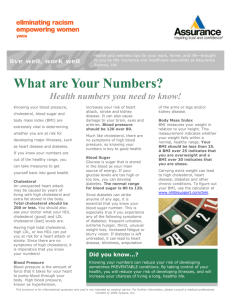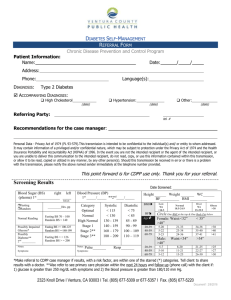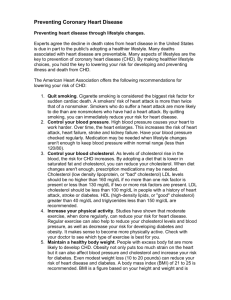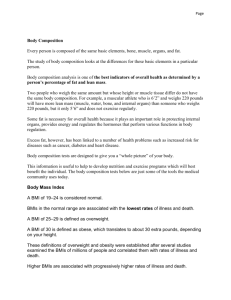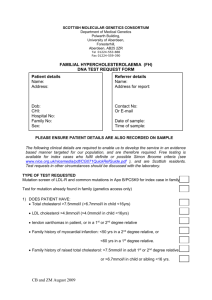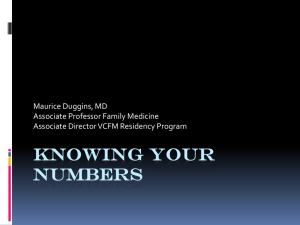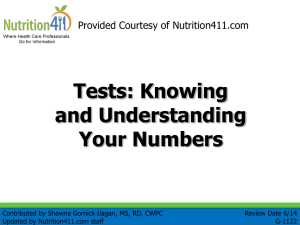Controlling Your Risk Factors
advertisement
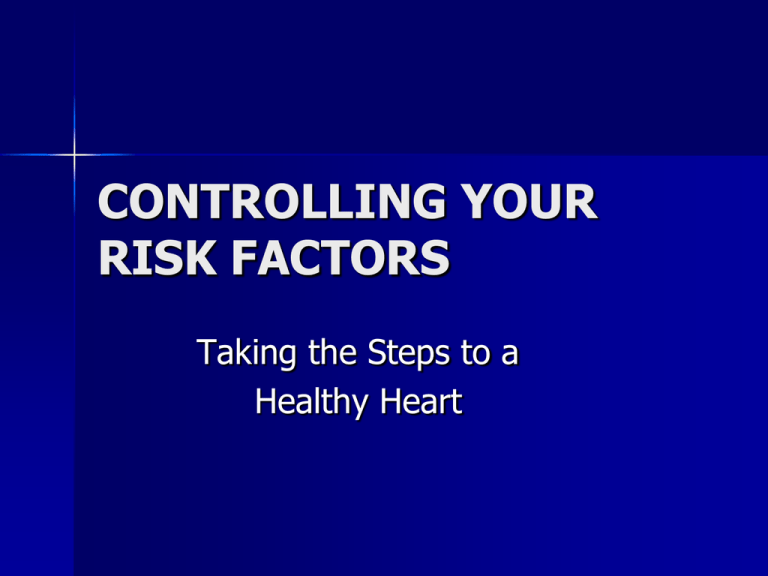
CONTROLLING YOUR RISK FACTORS Taking the Steps to a Healthy Heart The Uncontrollable Risk Factors Increasing Age Male Gender Family History What Are Your Controllable Risk Factors For Heart Disease? Smoking Abnormal Cholesterol High Blood Pressure Diabetes Sedentary Lifestyle (Inactivity) Unhealthy Body Weight Unmanaged Stress Tobacco Use Smoking is the #1 preventable cause of premature death in US Risk of CAD is 2-4 times higher than nonsmokers Types of tobacco Secondhand smoke Take Action! Call 1-800-Quit-Now Quit for Good S - Set a quit date T - Tell people A - Anticipate challenges R - Remove tobacco T - Talk to your doctor CHOLESTEROL Heredity and lifestyle Fatty deposits collect in arteries Reduced blood flow Increased risk of heart attack, stroke, aortic aneurysm, & PAD. What are ideal cholesterol (lipid) values? LDL Cholesterol “bad” < 70 mg/dL HDL Cholesterol “good” – 40 mg/ dL or higher for men – 50 mg/dL or higher for women Triglycerides < 150 mg/dL How can you control your cholesterol? Follow a heart healthy eating plan Eat more fiber Take your medications as prescribed Exercise regularly Maintain an ideal body weight Control blood sugars OBESITY 127 Million adults are overweight, 60 M obese, 9 M severely obese 1. Obesity accounts for 280,000-350,000 deaths per year 2nd leading cause for preventable deaths in U.S. Waist Measurement and the Body Mass Index are the recommended ways to estimate body fat. Body Mass Index (BMI) > 25 kg/m2 Waist Circumference > 40” (102 cm) in men Waist Circumference > 35” (89 cm) in women Booth, F.W., et al., J Appl. Physiol. 88:774-787,2000. Body Mass Index (BMI) BMI BMI BMI BMI 18 to 24.9 is Normal 25.0-29.9 is Overweight >30 is Obese >40 is Extremely Obese To Calculate…Multiply your weight by 703, divide by your height in inches, then divide again by your height in inches Body Mass Calculator-americanheart.org/bodymass. How Can You Help to Control Your Weight? Follow a heart healthy diet low in saturated fat Watch portion sizes Do not skip meals Make sure you are getting enough fiber Drink plenty of water Exercise daily Set realistic goals – weight loss should be gradual (1-2 pounds per week) EFFECTS OF OBESITY ON HEART DISEASE RISK Raises blood cholesterol and triglyceride levels Lowers HDL “good” cholesterol Raises blood pressure levels Increases your risk of developing diabetes HYPERTENSION=Silent Killer Blood pressure ≥ 120/80 mm Hg on at least 2 separate occasions OR on antihypertensive medication. When left uncontrolled, it can damage blood vessels leading to problems such as heart and vascular disease, stroke and peripheral arterial disease. What can you do to lower your blood pressure? Eat healthier: Limit the amount of fat and salt in your diet Lose weight if you need to Begin a regular exercise program Learn to manage stress If you smoke, QUIT Drink alcohol in moderation Diabetes 20.8 million people have Diabetes, 6.2 million people are undiagnosed.1. Diabetes is equivalent to having the diagnosis of Heart Disease. Insulin resistance is a characteristic of Type 2 Diabetes. Diabetes cause many metabolic abnormalities causing vascular changes leading to heart disease. Diagnostic Criteria – Fasting blood sugars >126 mg/dL X 2 tests “Pre-Diabetes” Also called impaired fasting glucose. A person with “prediabetes” will have a fasting blood sugar of 100-125 mg/dL. Increases a person’s risk for developing Type 2 Diabetes, heart disease and stroke. A 5-10% reduction in body weight will produce a 58% reduction in developing Diabetes. What can you do to lower blood sugars? Exercise daily Take your medications as directed Eat a diet rich in fiber and low in refined carbohydrates Weight loss Physical Inactivity ¼ of all adults have completely sedentary lifestyles. More than 60% of all adults are not regularly physically active and 60% are overweight. The Surgeon General’s Report recommends we are to accumulate 30 minutes or more of physical activity on most days of the week. Benefits of ExerciseExercise…… is the only treatment that improves all risk factors for Heart Disease!!!!! Numbers that Count for a Healthy Heart Ideal Blood Pressure <120/80 mm Hg Fasting Blood Sugars<100 Body Mass Index<25 Waist Circumference Women < 35” Men < 40” Physical Activity-30 minutes of moderate intensity all days of the week. Strength Training at least 2 days per week Cholesterol – LDL cholesterol<70 – HDL cholesterol >50 for women HDL cholesterol >40 for men -Triglycerides<150 Other Contributing Factors…. Stress/Anxiety/Depression-Will Alcohol-Increases Triglyceride, body increase heart rate and blood pressure. weight and blood pressure. Excessive alcohol can cause enlargement of the heart. – Women: NO more than 1 drink per day – Men: NO more than 2 drinks per day 1 drink= 5 oz. wine, 1 oz. liquor or 12 oz. beer FINAL THOUGHTS… “Our understanding of Heart Disease has expanded enormously over the past 30 years. We know that combining necessary medications with important lifestyle choices dramatically decreases future risk of a heart attack. You have the power to make these choices every day of your life and to teach the next generation the importance of heart-healthy living !!” Dr. Pearson, Dean/St. Mary’s Preventive Cardiology

